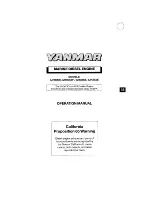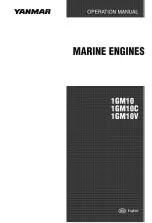
3
– English
EN
• If the power cord is damaged, the product may not be used as the cord cannot be re-
placed. In such cases, contact the installer/manufacturer.
From an electrical perspective, the motor must be permanently powered by means of a
permanent connection to the mains electricity (verify compatibility on the label attached
to the motor). To connect the motor to a push-button control panel and the mains electric-
ity, refer to
fig. 5
. The connection cable wires have the following function:
– Brown
= electric ascent or descent phase.
– Black
= electric ascent or descent phase.
– Blue
= Common (normally connected to the Neutral).
– Yellow-Green
= Ground (protective electrical bonding).
4.4 • Associating the Up and Down
movements with the respective
pushbuttons
On completion of connections, power up the motor and check whether the Up and
Down movements are associated correctly with the relative control pushbuttons. If this is
not the case, invert the connection between the
Brown
and
Black
wires.
LIMIT SwITCH aDJuSTMENT
5
5.1 • Limit positions on opening and closing
During the up and down movements, the motor stops the shutter automatically when it
reaches the limit switch positions (
fig. 4
): position “
0
” (shutter totally retracted) and po-
sition “
1
” (shutter totally extended). The factory settings of these positions are very ap-
proximate, and therefore follow the procedure below to adapt them to the specific di-
mensions of the roller shutter concerned.
5.2 • Adjusting first limit position “0” and then
limit position “1”
01.
Move the shutter to position “1”.
Align the adjustment screws with the respective limit positions:
02.
Stand in front of the shutter and note the following:
a
) the location on the roller of the limit position adjustment screws: right or left?
b
) if the extended section of the shutter is in front of or behind the roller.
03.
Then refer to
fig. 1
and check which diagrams correspond to the situations a)
and b) noted on your installation.
Very important – The identified dia-
gram assigns a specific limit position to be set on each adjust-
ment screw.
Setting limit position “0”:
04.
Activate the shutter so that it moves towards position “0” and wait for the motor to
stop on activation of the limit switch pre-set with the factory settings.
Caution!
– If the shutter moves beyond the point at which limit switch “0” is to be
fixed, stop movement and then activate the shutter to move it back to the starting po-
sition; then turn the adjustment screw of limit position “0” through a few turns in the
direction of the “–” sign and repeat the procedure from point 04.
05.
Gradually turn the adjustment screw of limit position “0” in the direction of the “+”
sign, to the required stop position “0”.
Note
– on each turn of the screw, the motor
moves to stop in the new position.
Setting limit position “1”:
06.
Turn the adjustment screw of limit position “1” through a few turns in the direction of
the “–” sign.
07.
Activate the shutter so that it moves towards position “1” and wait for the motor to
stop on activation of the limit switch pre-set with the factory settings.
Содержание TG M
Страница 2: ...3 C L N M FUSE 5 4 6 a b a1 2...
Страница 3: ...d c 10 mm M 1 2 e f h g...
Страница 16: ...1 ZH 1 1 1 1 2 3 2 5 m 40 cm 2 PVC 1 3 2 4 0 1 4...
Страница 17: ...2 ZH 3 3 1 S 35 mm 40 mm M 45 mm 30 Nm 52 mm M 45 mm 30 Nm 60 mm 3 2 6 4 4 1 III 4 2 1 5 m 4 3 5 4 4...
Страница 18: ...3 ZH 5 5 1 4 0 1 5 2 0 1 01 1 02 a b 03 1 a b 0 04 0 0 0 04 05 0 0 1 06 1 07 1 1 1 07 08 1 1...
Страница 19: ...4 ZH 0 1 0 1 0 1 0 1 1...
Страница 20: ...5 ZH 6 7 1 2 3...
Страница 52: ...IS0274A00MM_25 09 2013...







































